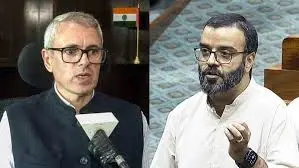National Conference a divided house: Why Omar Abdullah, Aga Ruhullah were at loggerheads at recent party meeting

Historical Context: The National Conference’s Legacy
Before diving into the specifics of the recent dispute, it is essential to understand the party’s background. Founded in 1932 by Sheikh Abdullah, the National Conference has been instrumental in shaping Jammu and Kashmir’s political journey. Over the decades, the party has oscillated between moments of dominance and phases of internal turmoil. Omar Abdullah, as Sheikh Abdullah’s grandson, represents the party’s legacy and has been a central figure in its modern political narrative.
Aga Ruhullah, on the other hand, emerged as a grassroots leader known for his organizational skills and ability to connect with local constituencies. His rise in the party has been marked by a push for structural reforms and a more aggressive stance on certain policy issues, which sometimes contrasts with the older leadership’s approach.
The Meeting That Sparked Controversy
The recent party meeting, convened to discuss electoral strategies and organizational reforms ahead of upcoming regional elections, became the stage for a heated confrontation. Sources present at the meeting describe a sharp disagreement between Omar Abdullah and Aga Ruhullah over several key issues:
- Leadership Style and Decision-Making: Omar Abdullah reportedly favored maintaining the party’s traditional consultative leadership style, emphasizing consensus and cautious political maneuvering. Aga Ruhullah, however, pushed for a more centralized and assertive leadership model, arguing that the party needs to adapt to the rapidly changing political realities in Jammu and Kashmir.
- Candidate Selection and Electoral Strategy: A major flashpoint was the disagreement over candidate selection for upcoming elections. Aga Ruhullah advocated for introducing new faces and youth leaders to rejuvenate the party’s image and broaden its appeal. Omar Abdullah, while not opposed to youth involvement, was cautious about sidelining veteran leaders, emphasizing the need to balance experience and new talent.
- Approach to Regional Alliances: The two leaders also clashed on the party’s approach toward alliances with other regional political entities. Omar Abdullah leaned toward maintaining a cautious distance, wary of compromising the party’s identity, while Aga Ruhullah appeared more open to tactical partnerships aimed at countering dominant political forces in the region.
Underlying Causes of the Rift
While the immediate reasons for the discord were policy and strategy disagreements, deeper undercurrents have been shaping the rivalry:
- Generational Divide: Omar Abdullah represents the older guard, deeply connected to the party’s historic legacy and traditional leadership norms. Aga Ruhullah symbolizes a newer generation pushing for reform and modernization, often impatient with what they perceive as outdated political practices.
- Power Dynamics: With changing political realities in Jammu and Kashmir, there is an ongoing contest for influence within the party. Aga Ruhullah’s growing prominence challenges the long-established leadership, leading to inevitable friction.
- External Pressures: The altered political scenario post the abrogation of Article 370 and increased central government influence has forced the National Conference to rethink its strategies, creating tensions around how best to respond to these external pressures.
Impact on Party Cohesion and Future
The fallout from this confrontation has revealed cracks in the National Conference’s internal cohesion. Party insiders suggest that the divide risks paralysing decision-making processes at a critical juncture when the party needs to consolidate its base and present a united front to voters.
Some analysts argue that if the party fails to reconcile these differences, it may lose ground to rival political formations better able to adapt to the evolving political landscape. Others see the clash as a potentially healthy sign of internal democracy and debate, which could ultimately lead to necessary reforms.
Reactions from Party Cadre and Observers
Within the party cadre, reactions have been mixed. Long-time loyalists of Omar Abdullah express concern over the growing dissent, fearing it may weaken the party’s traditional structure. Meanwhile, supporters of Aga Ruhullah believe that the party must evolve or risk irrelevance, urging the leadership to embrace change.
Political observers point out that such internal conflicts are not unusual in parties with long legacies but stress that the National Conference’s survival depends on its ability to manage these differences without fragmenting.
Conclusion: A Crossroads for the National Conference
The recent altercation between Omar Abdullah and Aga Ruhullah at the National Conference meeting reflects broader challenges confronting the party. As Jammu and Kashmir undergoes significant political transformation, the NC faces a critical choice: to either cling to legacy politics or to embrace change and modernization.
Whether this internal rift leads to meaningful reforms or further deepens divisions will be decisive in shaping the party’s trajectory in the coming years. For now, the National Conference remains a divided house, grappling with its identity amid shifting political sands.






